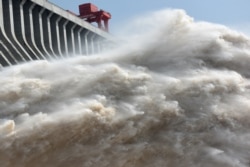The 2,000 people of Muhe, China moved to higher ground about 10 years ago to escape the rising Yangtze River.
Muhe lost half its territory because of the Three Gorges Project. A huge dam was designed to control flooding, create electricity and help navigation.
The Chinese government has spent more than $86 billion since 2011 to deal with issues like the ones that affected the village of Muhe. But many problems remain.
The Yangtze River
The Yangtze River flows more than 6,000 kilometers from Tibet to the city of Shanghai on China’s eastern coast. It supplies water for about 400 million people.
Protecting the Yangtze River has become a top goal for China after President Xi Jinping promised to end big and “destructive” development along the waterway.
Since Xi’s orders in 2016, local governments have moved factories and restricted farming and construction along the river, among other actions.
“You can say we have undergone earth-shattering changes, especially when it comes to increasing our awareness of environmental protection,” said Liu Jiaqi, the Communist Party secretary in Muhe.
Problems since the completion of the dam
But the dam itself lies near two fault lines on the Earth’s surface. It has been blamed for an increased number of earthquakes in the area.
China’s environment ministry said the area had as many as 776 earthquakes in 2017. That is an increase of about 60 percent from one year earlier.
The total number of earthquakes has risen since the project began. One study from the China Earthquake Administration found that, between 2003 and 2009, the number of quakes increased 30 times. That time period is when the huge lake behind the dam began to fill.
Xie Deti is a professor at Chongqing’s Southwest University. Xie said other problems include algae blooms and wastewater pollution.
The government has long said the good results of the dam outweigh the costs. But in 2011, officials promised to spend $177 billion by 2020 to try to fix some of the problems. Less than half of that money had been spent by the end of last year, Xie said. The professor told the Reuters news agency that officials in Beijing had said that the rest of the money would come between 2020 and 2025.
But one government scholar, who did not want to be identified, said the additional money might not be enough to solve the long-term problems.
Other problems include sediment that is building up behind the dam. The sediment threatens to harm flood control measures.
The lake, which absorbs more heat than dry land, has also been blamed for increasing temperatures in the area. Warmer water and destruction of wild areas have hurt local wildlife, with some animals, such as the Yangtze sturgeon, coming close to disappearing.
Since the dam was completed, some leaders have distanced themselves from the project. Wen Jiabao, premier from 2003 to 2012, is one example.
During his visit to the Three Gorges Dam last April, President Xi criticized officials for failing to clean up the “grim” environment of the Yangtze.
But Xi also described the dam as an example of China’s abilities and independence, saying it made him proud of his country.
“The issue is obviously very complicated, and it is not black and white,” said Ma Jun. He established the Institute of Public and Environmental Affairs, a non-governmental organization that studies water pollution.
“It does have both flood control and power generation functions, but on the other hand, whether the cost is too high, whether there are alternatives, I think those are what we need to study,” Ma added. “For good or bad, the heyday of dams has passed.”
I’m John Russell.
David Stanway reported on this story for Reuters. John Russell adapted it for Learning English. Mario Ritter Jr. was the editor.
_________________________________________________________________
Words in This Story
awareness – n. knowing that something (such as a situation, condition, or problem) exists
fault – n. geology : a break in the Earth's crust
algae bloom – n. a large increase in the population of algae
sediment – n. material that sinks to the bottom of a liquid
grim – adj. causing feelings of sadness or worry : gloomy or depressing
function – n. the special purpose or activity for which a thing exists or is used
alternative – n. something that can be chosen instead of something else : a choice or option
heyday – n. the time when someone or something is most successful, popular, etc. — usually singular
We want to hear from you. Write to us in the Comments Section.









